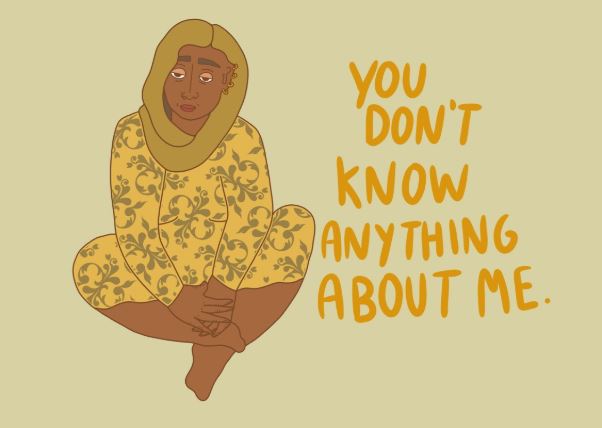CONFRONTING THE PREJUDICE AGAINST MUSLIM WOMEN
Exploring the depictions and perceptions of Muslim women in modern society
By Shilpa Caute

Illustration by Lauren Drinkwater
The two most recent depictions of Islamist women available to the British public in the past year have both resulted in an increase in polarisation.
The infamous story of Shamima Begum and the BBC drama The Bodyguard have both revealed a troubling public focus for hate and Western patriarchy’s idea of Islam as one evil and women as another.
Shamima Begum’s story quickly became front-page news in the UK, dividing public opinions. Shamima left the UK at the age of fifteen and was groomed and indoctrinated into Islamic State. The eventual deprivation of her British citizenship by Home Secretary Sajid Javid, points towards a negative and worrying Islamophobic attitude in Western society at this time. You do not have to look far to find more evidence of this within the UK government. In August last year, ex-Foreign Secretary Boris Johnson said Muslim women wearing burkas “look like letter boxes”, a de-humanising statement not only encouraging anti-Muslim hatred but also intentionally fuelling hatred towards women who wear burkas. Baroness Warsi told the BBC that parts of the Conservative party had been "in denial" about the issue of Islamophobia and a "clear statement" was needed about what was to be done to tackle it.
The topical story regarding terror and immigration sparked a nationwide debate, whilst simultaneously highlighting the tendency within society to capitalise on a lack of knowledge. It also raised the issue of a general lack of societal acknowledgment of patriarchal cultures and the vulnerability of young women. An underage girl is more vulnerable and susceptible to grooming than an adult, and also an easier target for indoctrination. Shamima married underage only ten days after arriving in Syria, before giving birth to three children who have now all died. These signs that she was a victim and target of indoctrination were seemingly bypassed when her citizenship was revoked.
Furthermore, it seemed that public opinion on this case was swayed by an interview that Shamima gave to the press, in which she made comments supporting terrorist attacks. She had no appropriate adult, social worker or lawyer present when she spoke. Public opinion also appeared to be a major contributor in Sajid Javid’s decision particularly considering that Home Secretary interventions on cases like this are rare. It indicates that this intervention was down to mass coverage of the case and huge public outrage.
Whilst the statements she made were dreadful and horrifying, society’s ignorance, whether wilful or not, regarding indoctrination and grooming have resulted in a higher level of intolerance. We must note that indoctrination can lead to desensitisation, dehumanisation and in this case a normalisation of violence. The deprivation of her British citizenship rejected an opportunity to learn from and understand why young British women are joining Islamic State, also breaking international convention, leaving Shamima a stateless person. It has halted the progress that should be being made in the further prevention of this and protection of underage British citizens.
The ending to the BBC series The Bodyguard was also particularly telling of the current perception of Islamist women.
The final episodes’ plot-twist reveals Nadia, a female Muslim, to be behind all the terrorist attacks that have happened during the series. The majority of viewers seemed to agree that the conclusion to the series was somewhat disappointing, with The Guardian describing it as an “ultimately unsophisticated resolution”, but not for its predictable scapegoat of the Muslim woman. The ending felt easy and perpetuated by racist narratives. As a result, it was much more likely to the public that an Islamic woman would have committed these terrorist acts than a white organised crime unit, which was the apparent perpetrator throughout. This disappointing ending highlighted Islamophobic undertones to the plot, specifically towards Islamic women.
The series has however been praised for its more profound take on toxic masculinity, in the protagonist’s (David Budd) inability to go to a counsellor and deal with this Post Traumatic Stress Disorder until the series finale. This is after Budd has managed to clear his name as the suspected perpetrator. Budd’s happy ending is juxtaposed with the plot twist previously mentioned. Troubling, racist narratives thus become the audience’s take-away from the series, which suggests that a white man can address his vulnerability and the blame can be easily shifted onto an Islamic woman, the white man meeting his role as the hero and reuniting with his family.
The series gained the highest viewing figures for the BBC in the past ten years, with the Guardian placing it third in a list of the best TV shows of 2018. Instead of using its’ high profile to raise awareness, the series wasted its’ potential in continuing to feed the British public’s growing Islamophobic attitudes and ignorance.
What both Shamima Begum and The Bodyguard tell us about modern depictions and perceptions of Muslim women is that they are as much about our lack of understanding and intolerance as a reactionary society as about the actual Muslim women. This intolerance and disregard for Western patriarchy has left a vulnerable British female national stateless, an outcome not dissimilar to that of the character Nadia. These outcomes are discouraging and indicate little progress not only in reducing Islamophobia but in Western patriarchal ideals ingrained into society.
Art by
Words by
Share this article

